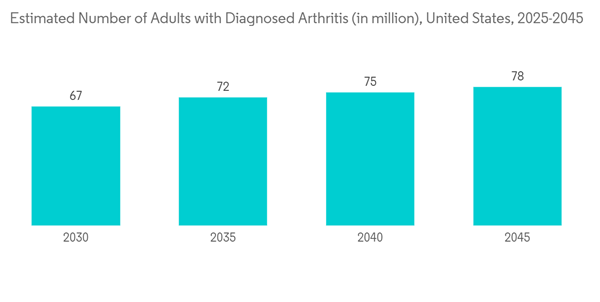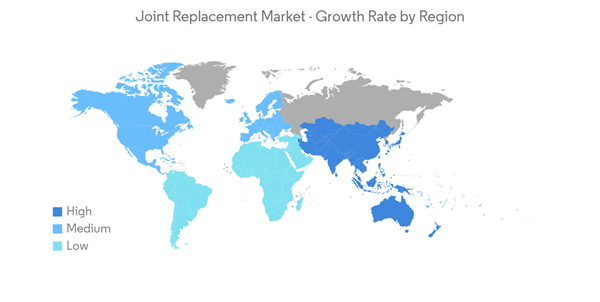The Global Joint Replacement Market size is expected to grow from USD 19.1 billion in 2024 to USD 23.7 billion by 2029, registering a CAGR of 4.6% during the forecast period (2024-2029).
The outbreak of COVID-19 adversely impacted the joint replacement market initially. For Instance, according to the NCBI research study published in April 2021, the first national lockdown on volume declined due to postponed joint replacement surgeries. The same source also stated that COVID-19 furth-19 further hampered access to surgery and lengthened wait times for operations due to the rising waiting lists for joint replacement surgeries and the rising prevalence of osteoarthritis. However, with the ease of restriction and resumption of surgeries, the market started to gain traction and is expected to continue the upward trend over the forecast period.
The key factors driving the market growth include the increasing prevalence of osteoarthritis, the rising cases of orthopedic injury, and an increasing geriatric population. For Instance, according to arthritis statistics 2022 published by the SingleCare team in January 2022, 2021 more than 350 million people have arthritis globally. With the growing incidences of osteoarthritis, the demand for joint replacement is expected to increase, further boosting market growth. Furthermore, the increasing geriatric population and several orthopedic injuries are also expected to drive the joint replacement market over the forecast period. For Instance, according to the WHO report published in October 2022, in 2030, 1 in 6 people in the world will be over 60 years old. The same source also stated that the proportion of the population aged 60 and over will increase from 1 billion in 2020 to 1.4 billion. Furthermore, by 2050, the world's population of people aged 60 and over will be doubled. Since the geriatric population is more prone to orthopedic disorders, an increasing number of the geriatric population is expected to drive the market.
Furthermore, adopting various strategies, including partnerships, mergers, and acquisitions by key market players and product launches, is also expected to drive market growth. For Instance, in March 2023, Stryker launched Mako Total Knee 2.0, the next chapter in Mako SmartRobotics, at the AAOS 2023 Annual Meeting in Las Vegas. The Mako Total Knee 2.0 consists of a new intuitive design, customizable workflow, and other key features, including an innovative digital tensioner that allows surgeons to assess knee stability during total knee arthroplasty (TKA) surgery without additional instruments. Similarly, in January 2022, Symbios launched the ORIGIN CR Total Knee System, which completes the ORIGIN product line with both monoblock and modular versions for lower back support. The product will allow surgeons to perform a custom posterior cruciate ligament (PCL)--preserving knee replacement. Thus, considerable market growth is expected over the forecast period due to such factors.
However, the availability of alternatives and the high cost of the procedure are likely to restrain the market growth over the forecast period.
Total knee arthroplasty (TKA), or total knee replacement, is one of the most frequently performed orthopedic procedures. Additionally, several studies have revealed an improvement in functionality after knee arthroplasty in the obese population. According to the Personalize Orthopaedics of the Palm Beaches, in November 2021, nearly 800,000 knee replacements were performed annually in the United States. According to estimates, knee replacement surgery is carried out about 800,000 times yearly in the United States alone, which keeps rising. Thus, increasing total knee replacement surgeries is expected to propel the segment growth.
Furthermore, product launches by the key market players and technological advancements are also expected to support the market growth. For Instance, in November 2021, OrthAlign, Inc., a privately held United States-based medical device and technology company, launched Lantern: the latest in smart, surgical technology for total and partial knee replacement surgery. Similarly, in July 2022, Enovis launched the Arvis wearable device with augmented reality visualization and an orthopedic navigation information system. The product is intended for the specific needs of hip and knee joint replacement surgery. Thus, such factors are expected to boost segment growth over the forecast period.
The growing product launches by the market players are one of the key factors propelling the market growth in the United States. For Instance, in January 2022, Smith+Nephew expanded the indications on its CORI Surgical System, a handheld robotic solution in total hip arthroplasty (THA). Smith+Nephew's RI. HIP NAVIGATION is designed to help maximize accuracy and reproducibility by delivering patient-specific component alignment for THA. Similarly, in August 2021, Zimmer Biomet Holdings, Inc. received United States Food and Drug Administration (FDA) 510(k) clearance of the ROSA Hip System for robotically-assisted direct anterior total hip replacement. Thus, owing to the factors above, the market is expected to witness a high growth rate in the United States over the forecast period.
This product will be delivered within 2 business days.
The outbreak of COVID-19 adversely impacted the joint replacement market initially. For Instance, according to the NCBI research study published in April 2021, the first national lockdown on volume declined due to postponed joint replacement surgeries. The same source also stated that COVID-19 furth-19 further hampered access to surgery and lengthened wait times for operations due to the rising waiting lists for joint replacement surgeries and the rising prevalence of osteoarthritis. However, with the ease of restriction and resumption of surgeries, the market started to gain traction and is expected to continue the upward trend over the forecast period.
The key factors driving the market growth include the increasing prevalence of osteoarthritis, the rising cases of orthopedic injury, and an increasing geriatric population. For Instance, according to arthritis statistics 2022 published by the SingleCare team in January 2022, 2021 more than 350 million people have arthritis globally. With the growing incidences of osteoarthritis, the demand for joint replacement is expected to increase, further boosting market growth. Furthermore, the increasing geriatric population and several orthopedic injuries are also expected to drive the joint replacement market over the forecast period. For Instance, according to the WHO report published in October 2022, in 2030, 1 in 6 people in the world will be over 60 years old. The same source also stated that the proportion of the population aged 60 and over will increase from 1 billion in 2020 to 1.4 billion. Furthermore, by 2050, the world's population of people aged 60 and over will be doubled. Since the geriatric population is more prone to orthopedic disorders, an increasing number of the geriatric population is expected to drive the market.
Furthermore, adopting various strategies, including partnerships, mergers, and acquisitions by key market players and product launches, is also expected to drive market growth. For Instance, in March 2023, Stryker launched Mako Total Knee 2.0, the next chapter in Mako SmartRobotics, at the AAOS 2023 Annual Meeting in Las Vegas. The Mako Total Knee 2.0 consists of a new intuitive design, customizable workflow, and other key features, including an innovative digital tensioner that allows surgeons to assess knee stability during total knee arthroplasty (TKA) surgery without additional instruments. Similarly, in January 2022, Symbios launched the ORIGIN CR Total Knee System, which completes the ORIGIN product line with both monoblock and modular versions for lower back support. The product will allow surgeons to perform a custom posterior cruciate ligament (PCL)--preserving knee replacement. Thus, considerable market growth is expected over the forecast period due to such factors.
However, the availability of alternatives and the high cost of the procedure are likely to restrain the market growth over the forecast period.
Joint Replacement Market Trends
Knee Replacement Segment is Expected to Hold a Significant Share Over the Forecast Period
Knee replacement surgery replaces parts of injured or worn-out knee joints. Surgery can help relieve pain and improve knee function. During surgery, damaged bones and cartilage are replaced with metal and plastic parts. The knee replacement segment is expected to witness major growth over the forecast period, owing to the rising burden of the geriatric population, the growing prevalence of osteoarthritis, and other chronic diseases like osteoporosis and diabetes.Total knee arthroplasty (TKA), or total knee replacement, is one of the most frequently performed orthopedic procedures. Additionally, several studies have revealed an improvement in functionality after knee arthroplasty in the obese population. According to the Personalize Orthopaedics of the Palm Beaches, in November 2021, nearly 800,000 knee replacements were performed annually in the United States. According to estimates, knee replacement surgery is carried out about 800,000 times yearly in the United States alone, which keeps rising. Thus, increasing total knee replacement surgeries is expected to propel the segment growth.
Furthermore, product launches by the key market players and technological advancements are also expected to support the market growth. For Instance, in November 2021, OrthAlign, Inc., a privately held United States-based medical device and technology company, launched Lantern: the latest in smart, surgical technology for total and partial knee replacement surgery. Similarly, in July 2022, Enovis launched the Arvis wearable device with augmented reality visualization and an orthopedic navigation information system. The product is intended for the specific needs of hip and knee joint replacement surgery. Thus, such factors are expected to boost segment growth over the forecast period.
North America is Expected to Witness Considerable Growth Over the Forecast Period
The primary driving factors for the growth of the North American joint replacement market are the growing burden of osteoarthritis in the country, increasing injury cases, increasing prevalence of obesity, increasing product approvals, increasing investments, and key initiatives taken by the key market players. For instance, according to the CDC report published in October 2021, about 1 in 4 United States adults (23.7%) or about 58.5 million people have doctor-diagnosed arthritis. Moreover, according to the Centers for Disease Control and Prevention (CDC) updated in October 2021, about 1 in 4 United States adults (23.7%) or about 58.5 million people have doctor-diagnosed arthritis. Furthermore, according to the report published by Statistics Canada in September 2022, around 1.0% of Canadians had arthritis yearly, and around one out of every 100 adult Canadians had rheumatoid arthritis. Thus, such a high burden of orthopedic diseases is expected to positively impact the market in North America.The growing product launches by the market players are one of the key factors propelling the market growth in the United States. For Instance, in January 2022, Smith+Nephew expanded the indications on its CORI Surgical System, a handheld robotic solution in total hip arthroplasty (THA). Smith+Nephew's RI. HIP NAVIGATION is designed to help maximize accuracy and reproducibility by delivering patient-specific component alignment for THA. Similarly, in August 2021, Zimmer Biomet Holdings, Inc. received United States Food and Drug Administration (FDA) 510(k) clearance of the ROSA Hip System for robotically-assisted direct anterior total hip replacement. Thus, owing to the factors above, the market is expected to witness a high growth rate in the United States over the forecast period.
Joint Replacement Industry Overview
The Joint Replacement market is highly competitive and consists of several major players. Companies like Stryker Corporation, Zimmer Biomet Holdings, Inc., Depuy Synthes (Johnson & Johnson), Smith & Nephew, and Wright Medical Group, among others, hold a substantial market share in the Joint Replacement market. Various developments have recently occurred in the market; market players are actively participating in new product launches, developments, and collaborations to expand their market share.Additional Benefits:
- The market estimate (ME) sheet in Excel format
- 3 months of analyst support
This product will be delivered within 2 business days.
Table of Contents
1 INTRODUCTION
4 MARKET DYNAMICS
5 MARKET SEGMENTATION (Market Size by Value - USD)
6 COMPETITIVE LANDSCAPE
Methodology

LOADING...










